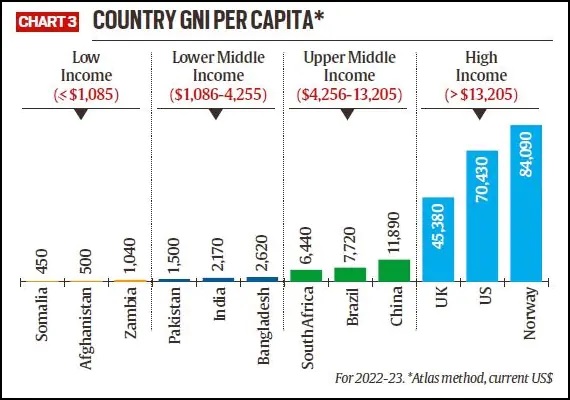Why in news?
In Independence Day address, PM Narendra Modi asked Indians to embrace “Panch Pran” (five vows) by 2047 when the country celebrates 100 years of independence.
The first vow is for India to become a developed country in the next 25 years.
What is a “developed” country?
- World Economic Situation and Prospects’ (UN) Classification
- Developed economies
- Economies in transition
- Developing economies
- The World Bank’s categorization - Based on Gross National Income (GNI) per capita
- Low income countries
- Lower middle income countries
- Upper middle income countries
- High income countries

Why is the United Nations classification contested?
- It can be argued that the UN classification is not very accurate and has limited analytical value.
- There are 31 developed countries according to the UN in all.
- Except 17 economies in transition, others are designated as “developing” countries, even though in terms of proportion, China’s per capita income is closer to Norway’s than Somalia’s.
- Then there are countries such as Ukraine, with a per capita GNI of 4,120 dollars (a third of China’s) that are designated as “economies in transition”.
Where does India stand?
- India falls under the categories of “developing economies” and “lower middle income countries”.
- GDP- Considering the absolute level of GD, India is one of the biggest economies of the world even though the US and China remain far ahead.
- Per capita income- However, to be classified as a “developed” country, the average income of a country’s people matters more.
- On per capita income, India is behind even Bangladesh.
- Developments- India has made a secular improvement on Human Development Index (HDI) metrics that has three factors.
- Health and longevity of citizens
- Quality of education
- Standard of life
- The life expectancy at birth in India has gone from around 40 years in 1947 to around 70 years now.
- India has also taken giant strides in education enrolment at all three levels — primary, secondary, and tertiary.
China’s per capita income is 5.5 times that of India, and the UK’s is almost 33 times.
- Distance left to cover- Even though India is the world’s third-largest economy in purchasing power parity (PPP) terms, most Indians are still relatively poor compared to people in other middle income countries.
- Metrics, such as the food share of consumption, suggest that even rich households in India would have to see a substantial expansion of their total consumption to reach levels of poor households in rich countries.
As of 2013, India had 218 million people living in extreme poverty — which made India home to the most number of poor people in the world.
How much can India achieve by 2047?
- Comparison with China- In per capita income terms, China was at India’s current level in the year 2007.
- Theoretically, if India were to grow as fast as China did between 2007 and 2022, then, it will take India another 15 years to be where China is now.
- India’s current HDI score (0.64) is much lower than what any of the developed countries had even in 1980.
- China reached the 0.64 level in 2004 and took another 13 years to reach the 0.75 level.
- World Bank’s 2018 report- By 2047, at least half the Indian citizens could join the ranks of the global middle class.
- Fulfilling these aspirations requires income well above the extreme poverty line, as well as vastly improved public service delivery.
